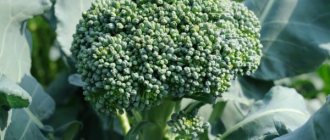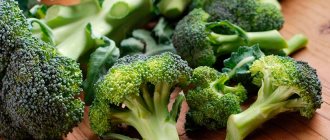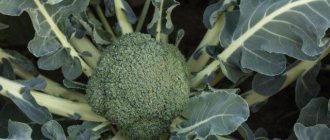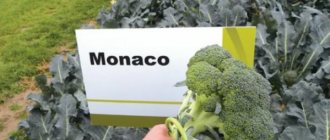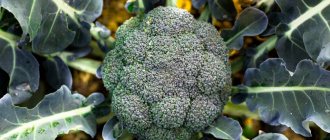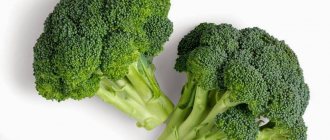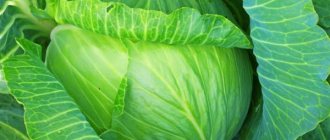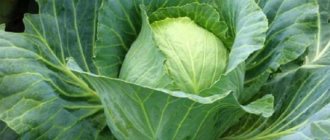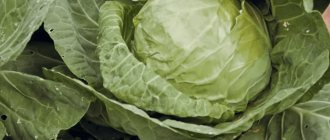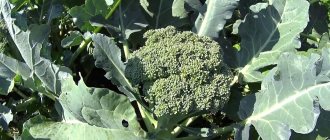Broccoli Green Magic is a high-yielding French hybrid characterized by early ripening. Suitable for cultivation in all regions of Russia. Shows stable yield even in unfavorable seasons for the crop. However, to maintain the high productivity of the hybrid, it is necessary to follow the rules of planting and further care, which must meet the requirements.
Broccoli Green Magic: features of the appearance of plants and heads of cabbage, yield, strengths and weaknesses
Description of broccoli Green Magic F1
The hybrid is distinguished by medium-sized plants with one stem, the height of which reaches 45 cm. The leaf rosette of Green Magic F1 broccoli is of a raised type. The plates of the hybrid are medium in size, gray-green in color. They are slightly bubbly with a wavy edge. The petioles are thickened and of medium length, without anthocyanin.
The head of this type of broccoli is elliptical, medium density, gray-green in color. The weight of Green Magic hybrid heads does not exceed 700 g. There are no covering leaves above the head. The taste of this species is assessed as excellent.
Productivity
Green Magic is an early ripening species; the harvest can be harvested 2.5 months after emergence. The heads ripen almost simultaneously in the garden. The yield level of the hybrid is 2.2-2.5 kg per 1 sq. m. The fruits are suitable for fresh consumption, canning and freezing.
Important! The fruiting period of this variety is long, since after cutting off the central head, the hybrid forms numerous lateral inflorescences weighing up to 140 g.
Sowing in open ground
Planting broccoli in open ground is used in mid-latitudes and southern regions, and you do not need to spend a lot of time caring for and growing seedlings. But seed germination with this method is much less. Sowing is carried out after frosts on the ground stop, most often this happens in the middle or second half of May.
Seed preparation is carried out according to the same scheme as with the seedling method. The beds are placed at a distance of 60 cm from each other. Seeds mixed with soil are sown in a shallow ditch. After the emergence of seedlings, they need to be thinned out, since neighboring specimens will compete with each other for nutrients. To avoid thinning, sowing is done immediately in small holes 30 cm apart, placing 2 seeds there. Then the sprouts are treated in the same way as adult plants.
Advantages and disadvantages
Broccoli Green Magic has many advantages that gardeners could appreciate. But the variety also has certain disadvantages that need to be taken into account when growing it.
The Green Magic broccoli variety was included in the State Register of Russia in 2008
Main advantages:
- early maturation;
- stable yield;
- excellent taste;
- high content of vitamins and minerals;
- resistance to temperature changes;
- versatility of use;
- low susceptibility to fungal diseases.
Flaws:
- needs protection from pests;
- requires regular watering and fertilizing.
Diseases and pests
The main enemy is the blackleg or clubroot. To avoid its development, broccoli is not planted in the place where cruciferous vegetables previously grew: it is not recommended to plant too densely.
To protect seedlings from slugs, crushed eggshells are crushed around the plants. Marigolds planted nearby help drive away the caterpillars. Preventing the appearance of these creeping insects near seedlings allows you to protect them from manual harvesting in the event of an attack.
To protect against cruciferous flea beetles, leaves are covered with ash or tobacco.
Landing rules
The hybrid can be grown by seedlings and direct sowing in the ground. However, in each specific case, certain planting rules must be followed, since the further development of seedlings and their productivity depend on this.
Growing Green Magic broccoli seedlings
Sowing of Green Magic broccoli seedlings should be done at the end of March, at the beginning of April. By the time of planting in a permanent place, the age of the seedlings should be 30-35 days. To grow seedlings, you need to prepare wide containers about 10 cm high. They must have drainage holes to remove excess water. You will also need a soil mixture of turf, sand, humus and peat, taken in equal quantities.
Important! The seeds of the hybrid Green Magic F1 do not require pre-sowing treatment, since the manufacturer took care of this.
A few days before planting, it is recommended to water the soil with a bright pink solution of potassium permanganate and then lightly dry it. This will prevent the development of root rot and blackleg at an early stage of seedling development.
Algorithm of actions:
- Place a 1 cm thick layer of drainage on the bottom of the container.
- Fill it with nutritious soil mixture.
- Water generously and level the surface of the substrate.
- Place the seeds at a distance of 1 cm.
- Sprinkle them with a 1 cm layer of soil.
- Moisten the soil surface with a spray bottle.
After planting, cover the container with film or glass and place it in a dark place with a temperature of +20 °C. After seed germination, the container should be moved to a bright windowsill and the maintenance regime should be lowered to +18 °C.
When the seedlings become stronger, they should be adapted to external conditions and the film or glass should be completely removed. Caring for Green Magic broccoli seedlings involves moderate watering as needed, as well as picking in the cotyledon phase.
Friendly shoots of the hybrid appear 3-5 days after planting
It is necessary to plant seedlings in a greenhouse or open ground when the soil has warmed to a depth of 10 cm. The recommended planting scheme for a hybrid is 30 by 50 cm. In case of threat of return frosts, the seedlings should be covered with agrofibre.
Sowing in open ground
To directly sow a hybrid in open ground, it is necessary to prepare the site at least two weeks in advance. To do this, you need to dig it up, add 10 kg of humus for each square. m and level the surface. Then you need to make holes up to 2 cm deep at a distance of 30 cm and, keeping a distance of 50 cm between rows. Place three seeds in each hole and sprinkle them with soil. After this, it is recommended to water the bed using sprinkling method and cover it with agrofibre. After about a week, when friendly shoots appear, it is recommended to remove the shelter. And when the seedlings get stronger, leave one of the strongest ones in the hole and remove the rest.
Mid-season varieties and hybrids
Curly head
Broccoli variety Curly head
An excellent productive variety is characterized by disease resistance and straightened forks, which are suitable for harvesting 80–95 days after full germination. Blistered, wavy leaves of a bluish-green color are planted on short petioles and collected in a raised small rosette. The head is medium-sized, rounded-flattened, with a lumpy grayish-green surface. The internal structure is moderately loose, the taste is excellent. The weight of the main fork is about 600 g.
After the main harvest is harvested, small additional heads grow on the stems, weighing 60–80 g each. The overall yield is good, reaching 24 kg per 10 square meters. m.
Batavia F1
Unpretentious, reliable cabbage is valued for the taste of large, meaty forks. The state register defines the hybrid as mid-season, but in the southern regions it shows itself to be early. The main heads are collected 60–65 days after planting the seedlings. The leaves are bluish-green, characterized by strong bubbly and waviness, the petioles are long, forming a raised rosette. The head is round, dome-shaped, with a dense, finely lumpy surface of a bluish-green color. The taste is excellent, weight is 0.7–1.1 kg.
The growing lateral heads are large, weighing up to 200 g each. The variety is disease-resistant, tolerates hot and dry weather without damage, the planting yield is up to 26 kg per 10 sq. m. Broccoli Batavia tolerates long-term transportation well, which is a significant advantage of this hybrid.
Surfing F1
The plants form large heads and have an enviable harvest. The green, vesicular leaves are collected in a medium-sized horizontal rosette on several stems. The large head is round, slightly flattened, and not covered with leaves. The surface is dark green, expressively tuberculate. Inflorescences of moderate density, excellent taste, weighing about 1 kg.
Plantings are practically not affected by diseases and pests. The yield of unpretentious cabbage reaches 37 kg per 10 square meters. m.
Care instructions
This type of broccoli, like others, is moisture-loving. And for the full formation of heads, it needs regular watering. Humidification should be carried out 1-2 times a week at moderate air temperatures, and daily during hot periods. Moreover, it is recommended to alternate watering at the root with sprinkling.
You need to feed Green Magic broccoli three times a season. It is recommended to fertilize for the first time ten days after the seedlings have adapted to the new location. During this period, you can use urea at the rate of 30 g per 10 liters of water. Subsequent feedings can be done once every two weeks. For them, it is recommended to use 30 g of superphosphate and 20 g of potassium sulfide per 10 liters of water.
Also, throughout the entire growing season, it is necessary to weed and hill up broccoli seedlings, which will strengthen the root system. These activities are recommended before the plants in the row close together.
Important! The level of hybrid yield directly depends on proper care.
Growing and care
Before the heads form, water generously with water at room temperature, applying it under the root. However, you should not let the roots turn sour. After the heads appear, reduce the amount of water and water less often. To maintain moisture balance, mulch the soil with hay, straw or peat.
Feed with homemade and mineral fertilizers. Young plants benefit from nitrogen organic fertilizers - a solution of mullein, chicken droppings, fermented nettle infusion. They are diluted with water 1:10 and added 0.5 liters per bush during watering. After tying the heads, feed them once with a mineral complex or several times with humate fertilizers.
Harvest and storage
Green Magic broccoli can be harvested at the end of July. It is important to observe the deadlines so that the vegetable does not bloom. Otherwise, its consumer properties are reduced. Optimal storage conditions: dark room, temperature +2 ° C and humidity at 60%. If all recommendations are followed, the vegetable retains its consumer properties for four weeks.
The heads need to be cut off with a petiole 10 cm long, which is also used for food.
Contraindications to eating broccoli
Broccoli varieties
Despite the many beneficial properties of cabbage, there are cases when eating broccoli is undesirable.
What is harmful in broccoli and can be hazardous to health:
- Do not use cabbage decoction for cooking. It contains adenine and guanine - substances harmful to the body. Therefore, when preparing vegetable soups, it is not recommended to boil the heads for a long time. With prolonged heat treatment, the beneficial properties of the vegetable are lost;
- Great harm can be done to the body from broccoli if you eat the heads fried in oil over high heat. During the frying process, carcinogens are formed that negatively affect health;
- It is recommended to eat raw vegetables with caution for people with gastrointestinal diseases. If you have high stomach acidity, it is not advisable to include fresh cabbage in your diet.
Kohlrabi, Brussels sprouts, Peking and Savoy cabbages for the Moscow region
In addition to broccoli, summer residents of the Moscow region recommend kohlrabi cabbage.
The best varieties: late - Giant and early - Vienna White.
Brussels sprouts are also grown. Some of the best varieties of Brussels sprouts for the Moscow region are Hercules and the Boxer hybrid.
This is a mid-late cabbage, has excellent taste and decorative appearance. Each small fruit weighs no more than 20 grams. One plant produces an average yield of 500 grams.
A special property of Brussels sprouts is its frost resistance and resistance to many diseases (especially hybrid varieties).
Also, many summer residents like to grow Chinese cabbage.
Many summer residents claim that the best varieties of Chinese cabbage for the Moscow region are Nika, Bokal, and Asten.
Residents of summer cottages near Moscow are also familiar with Savoy cabbage, which is grown in small quantities for the purpose of decorating dishes.
The most suitable variety for this region is considered to be Early Golden. You can also see the hybrid variety of Savoy cabbage Melissa.
We recommend viewing the following site publications
